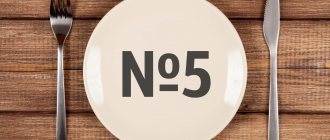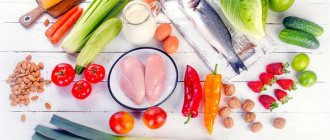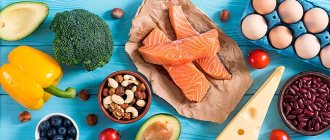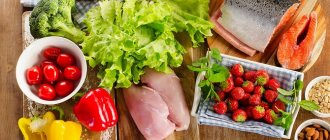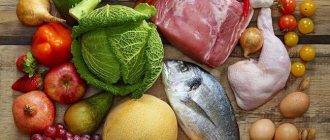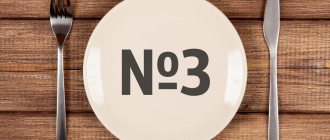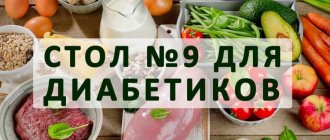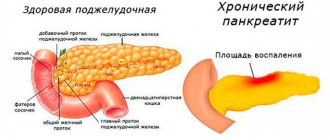The quality of nutrition has a significant impact on the health and condition of the body. By taking into account individual characteristics in the diet, using a special diet, you can correct certain problems inherent in the body.
Thus, for functional diseases and disorders of the nervous system, experts recommend using the “Table No. 12” therapeutic diet, developed in the 1930s by Manuil Isaakovich Pevzner, the founder of dietetics in the USSR, the author of 15 therapeutic diets.
Modern research in the United States also confirms the important role of human nutrition and lifestyle in the fight against neurological disorders.
In this article we will look at the essence of diet No. 12 according to Pevzner and what are the specific indications for following it.
The essence and purpose of the diet
A diet, often in addition to the main treatment, is prescribed for identified functional disorders and diseases of the nervous system.
Its beneficial effect is determined, firstly, by reducing the amount of carbohydrates, fat, salt consumed, and secondly, by the complete exclusion of central nervous system pathogens from the diet.
The latter include caffeine-containing drinks (coffee, tea, etc.), spicy foods, and foods fried in copious amounts of fat or oil.
Specific indications for prescribing diet No. 12 primarily include the following:
- diseases and disorders of the central nervous system (depression, neuroses, sleep disorders and emotional reactions);
- transition from therapeutic diet No. 10 (prescribed for diseases of the cardiovascular and circulatory systems) to rational nutrition.
We also recommend paying attention to the MIND diet to improve brain function.
The essence of therapeutic nutrition
Content:
- Application of diet
- The essence of therapeutic nutrition
- List of foods for diet
- Proper nutrition for the nervous system
- Additional measures for nervous system disorders
- Diet Conclusion
Soviet nutritionist Manuil Pevzner identified a number of foods that have a stimulating effect on the central nervous system. Based on this knowledge, he developed a specialized menu for people with mental disorders, which facilitates the course of the disease. Spices, salty, hot and sour dishes turned out to be such stimulating foods. Table No. 12 provides for the complete exclusion of the above dishes from the diet of a patient with mental disorders.
The patient is supposed to eat in small portions, but often. There should be at least 5 meals a day. The technique suggests having hearty breakfasts, less dense lunches and light dinners. If, before table 12 was prescribed, the patient’s nutrition differed greatly from the general rules of the method, the menu correction should occur gradually. A sudden diet change can cause additional stress.
Additionally, drinks that also excite the nervous system are excluded from the diet, namely coffee, strong black and green tea, energy drinks, and sweet carbonated drinks. Alcohol consumption is especially dangerous in cases of nervous system disorders. Drinking alcohol together with drugs used in the treatment of mental disorders is deadly. It is highly desirable to get rid of nicotine addiction, if you have one.
The patient's diet must be balanced in terms of its chemical composition. It is recommended to eat 300 g of slow carbohydrates (beans, cereals), 70-80 g of vegetable and animal protein (vegetables, meat, eggs), healthy fats up to 70 g per day. You should be especially careful with spices when preparing food. The amount of salt also needs to be reduced, the recommended amount per day is 6 g.
As for heat treatment, you should avoid frying in large amounts of oil. You can bake, boil, steam or cook in a slow cooker. It is advisable to consume food and drinks warm; too hot or cold is undesirable for the central nervous system.
In addition to nutrition, the patient should drink enough purified water. It is better not to use ordinary carbonated water; periodically it is useful to drink water enriched with useful minerals. The calorie intake per day should be no more than 2500 kcal.
Loss of appetite is a common occurrence when there is a malfunction in the nervous system; the patient may refuse to eat or, conversely, overeat. It is important to ensure that the diet is moderate and balanced.
General rules
As stated above, a diet involves avoiding consumption of certain food groups and limiting consumption of others.
In addition, an important component of the diet is to increase the consumption of healthy nutrients. As part of this diet, these include, first of all, those saturated with phosphorus salts (liver, legumes, dairy products).
As for the values of substances consumed from food and the distribution of the share of protein, fat and carbohydrate consumption, for diet Table No. 12 they are determined as follows for one day:
| Index: | Meaning: | Note: |
| Proteins: | From 80 to 95 grams; | The share of animal protein is from 50 to 60%; |
| Carbohydrates: | 350 grams; | — |
| Fats: | 70 grams; | At least 30% of fats are of vegetable origin; |
| Salt: | 6 grams; | — |
| Number of calories: | 2300-2400 kcal; | Depends on the individual characteristics of the body. |
The diet regimen is five meals a day. In addition, it is important to ensure that you regularly consume food at the same time every day. This not only helps to improve the functional effect of the diet, but also stimulates better metabolism and the absorption of nutrients from the food consumed.
Additional measures for nervous system disorders
Table No. 12 is used for sleep disorders, anxiety, feelings of fear, and decreased ability to work. These conditions may be a sign of a deficiency of beneficial components, which can be caused by poor, irregular nutrition and chronic stress.
Patients with disorders of the nervous system need to include in their diet a sufficient amount of fiber, which is rich in vitamin B. This vitamin is especially useful for improving the functioning of the nervous system. It can be obtained from fruits, cereals, and cereals. Also, foods rich in fiber have detoxifying and antioxidant effects, which is very important in increasing the body's immune defense and strengthening the nervous system.
Drinking regime is also important. For diseases of the nervous system, it is necessary to drink a sufficient amount of purified water. However, you need to remember that you should not drink water with food (or other drinks either) or drink it an hour before bedtime.
If the disease is accompanied by muscle spasms, tics, and other involuntary movements, it is recommended to consume more phosphorus. It is found in dairy products, liver, legumes, tongue, and brains.
For neurasthenia, increased excitability, nervousness, and unreasonable attacks of aggression, you need to eat food with magnesium. It normalizes blood pressure and pulse, has a calming effect, and has a positive effect on the functioning of the heart muscle. To make up for its deficiency, you need to add lentils, beans, chickpeas, buckwheat, nuts, and bran to the menu. The cause of the same irritability and seizures can be calcium deficiency. In addition to dairy products, they are rich in: beets, almonds, cabbage, and beans.
To improve brain activity, attention, and memory, it is recommended to introduce foods rich in iron into the diet. It can be obtained from white cabbage, turnips, seafood, buckwheat, and beef. In order for iron to be better absorbed, you need to add vitamin C to the menu. In addition to citrus fruits, there is a lot of it in berries: strawberries, rose hips, black currants.
After suffering stress, you need to consume more vitamin E. This element improves the activity of brain cells, and also has a beneficial effect on the functioning of the central and peripheral nervous systems, and regulates the emotional background. It can be found in sprouted wheat, peas, beans, lentils, eggs, and nuts.
For mild neuroses, excitability, neurasthenia and other functional disorders of the central nervous system, walks in the fresh air are mandatory. For frequent stress, short-term nervous tics, and aggression, it is recommended to add reading positive books (“Dandelion Wine” by Ray Bradbury, “Pollyanna” by Eleanor Porter, “Three Cups of Tea” by Greg Mortenson and others).
Sample menu for the week
Below is a sample menu for the week, taking into account dietary requirements. The described distribution of products during the week and each day is advisory, informational in nature and involves the formation of your own diet, taking into account the individual characteristics and intolerances of the body in each specific case. This is what the recommended menu for every day looks like:
Monday
| Meal: | Products: |
| Breakfast: | 1 egg, a glass of orange juice, a cup of herbal tea, whole grain bread, goat cheese; |
| Lunch: | 2 cheesecakes with sour cream and a glass of water (carbonated or not); |
| Dinner: | borscht with lean beef, seaweed salad, hake, rice; |
| Afternoon snack: | Apples or other seasonal fruits, herbal tea, milk; |
| Dinner: | veal, vegetable salad. |
Tuesday
| Meal: | Products: |
| Breakfast: | 1 glass of water, oatmeal with honey and dried fruits; |
| Lunch: | apples or other seasonal fruits, herbal tea, milk; |
| Dinner: | cabbage soup in chicken broth with cereal, beef, legumes; |
| Afternoon snack: | Caesar with chicken breast (without croutons), herbal tea, juice or water; |
| Dinner: | Zucchini pancakes, baked sea bass fillet. |
Wednesday
| Meal: | Products: |
| Breakfast: | millet porridge with pumpkin and honey, herbal tea, orange juice or grapefruit; |
| Lunch: | red grapes, 2 cheesecakes with honey, jam or sour cream, water; |
| Dinner: | vegetable soup (minestrone), falafel, fried cheese; |
| Afternoon snack: | cookies, dried fruits and hibiscus tincture (hibiscus); |
| Dinner: | durum wheat pasta with seafood and cream sauce. |
Thursday
| Meal: | Products: |
| Breakfast: | 2 eggs, orange juice, hummus with whole grain bread; |
| Lunch: | fruits or dried fruits, honey, nuts and cranberry juice; |
| Dinner: | Lean fish soup, seaweed or soy asparagus, beef, chicken or turkey cutlets; |
| Afternoon snack: | cookies with milk/cottage cheese; |
| Dinner: | fried red mullet with a side dish of rice, vegetables or a small portion of baked potatoes. |
Friday
| Meal: | Products: |
| Breakfast: | cheesecakes with honey or sour cream, a glass of water, yogurt; |
| Lunch: | cottage cheese, bananas, herbal tea; |
| Dinner: | soup with meatballs, lean lamb with vegetable side dish, hot herbal tea; |
| Afternoon snack: | salad of beans, tomatoes and tuna, flavored with mild spices and vegetable oil, whole grain bread; |
| Dinner: | red or brown wild rice, pike cutlets, vegetables. |
Saturday
| Meal: | Products: |
| Breakfast: | 2 cheesecakes with sour cream, honey or jam, nuts, herbal tea; |
| Lunch: | 1 grapefruit, bananas, mangoes or peaches; |
| Dinner: | soup with meat or chicken broth with cereals, vegetable salad, lean beef or beef tongue; |
| Afternoon snack: | rice porridge with milk, herbal tea or water; |
| Dinner: | salad (warm) with cod liver and boiled egg, whole grain bread. |
Sunday
| Meal: | Products: |
| Breakfast: | oatmeal with apple or berries, nuts and honey, 2 glasses of water; |
| Lunch: | beef liver with whole grain bread, jelly or fruit drink; |
| Dinner: | soup with meat or chicken broth with cereals, lean fish with rice or vegetable side dish; |
| Afternoon snack: | fruits, cereals, nuts, dried fruits, honey, herbal tea. |
| Dinner: | Veal medallions with vegetable salad, water. |
Products can be varied taking into account the above recommendations for consumption: replace meat with liver, replace some fruits with others (taking into account the principle of seasonality, providing benefits and protection from the entry into the body of unwanted elements used as growth stimulants).
List of foods for diet
In order to improve the activity of the central nervous system, Pevzner recommended introducing more fortified foods into the menu. The central nervous system needs all micro- and macroelements, most vitamins. A deficiency of one or more components can be the root cause of the disease.
First of all, diet 12 excludes those foods that irritate the central nervous system or do not provide any benefit. For the twelfth table the following are prohibited:
- hot spices and seasonings;
- mustard, horseradish, Tabasco, spicy ketchup;
- fresh baked goods, puff pastry;
- fried and hard-boiled eggs;
- sour and salty cheeses and drinks: feta cheese, matsoni;
- garlic and onions, radishes, radishes, cucumbers;
- spinach, sorrel, basil;
- cocoa, black coffee, alcohol, strong tea, sweet soda;
- salted fish, caviar;
- chocolate and products containing it;
- canned food, smoked meats;
- marinades, pickles, fermented products.
When purchasing ready-made products, it is advisable to study their composition well, especially sausages, dairy products, and desserts.
The menu for table No. 12 includes:
- Meat and fish - you need to choose low-fat types. Suitable: rabbit, turkey, chicken, pure veal and beef fillet, horse meat, hare. For seafood, you can use lean fish and shellfish: hake, pollock, carp, eel, mussels, shrimp, crucian carp, gobies, etc. Meat and fish dishes can only be prepared in a gentle way: boiling, baking, steaming.
- Bread – only yesterday’s baked bread. Any varieties are suitable: white, rye, bran, oatmeal. If possible, it is better to cook salt-free baked goods. Yesterday's pies, savory buns and cookies, biscuits, crackers, and dry biscuits are allowed.
- Dairy products should be chosen with low fat content. It is recommended to introduce more cottage cheese and kefir into the diet, and dishes with them. You can use natural yogurt without dyes or flavorings, whole milk, hard cheeses, and low-fat sour cream.
- Vegetables – except those prohibited. The usual onions can be replaced with leeks.
- Chicken and quail eggs are allowed in limited quantities. No more than 2 pieces of chicken or 4 pieces of quail are allowed per day. You can cook soft-boiled, steamed omelettes, or add to dishes.
- Vegetable oil and butter should be consumed in moderation. You can use sunflower, olive, sesame, flaxseed and other types. Butter is allowed only in melted form.
- Fruits and berries – it is advisable to choose according to the season and place of origin. It is necessary to use varieties that are not too sour: blueberries, pears, apples, gooseberries, etc.
- Healthy drinks - the usual coffee should be replaced with less aggressive types. Suitable teas: linden, rosehip, sea buckthorn, chamomile. Special herbal mixtures are allowed to normalize nervous activity; they can be purchased at the pharmacy. In addition, you can prepare compotes, fruit drinks, and freshly squeezed juices.
For more severe mental and nervous system disorders such as epilepsy, attacks of catalepsy, the diet is prescribed individually by a doctor, taking into account the characteristics of the course of the disease and the deficiency of certain components.
Several suitable recipes
Below are several recipes that meet your diet requirements.
Hake in Moscow style
A simple and tasty dish suitable for lunch or dinner. What you will need:
- hake – 500 grams;
- potatoes – 1 kg;
- tomatoes – 500 grams;
- cheese – 200 grams;
- green onions - several pods.
It is prepared as follows:
- Preheat the oven to 200°C. N
- and on a baking sheet greased with vegetable or butter, the potatoes cut into slices are placed.
- Hake fillet cut into small pieces is laid out on top.
- Place on top in layers: tomatoes (in rings), potatoes, grated cheese. It is important to cut the potatoes thin enough so that the cooking time roughly coincides with the time the fish is ready.
- The cooking process in the oven takes 30-45 minutes.
If desired, the dish can be seasoned with green onions.
Veal stewed with vegetables
What you will need:
- veal – 500 grams;
- zucchini – 200 grams;
- eggplants – 200 grams;
- tomatoes – 1-2 small tomatoes;
- celery (root) – 1-2 pieces;
- bell pepper – 1-2 pieces.
The recipe is just as simple:
- Line a baking sheet with foil and preheat the oven to 200-220°C.
- Cut all the ingredients into small cubes, lightly grease with oil, add salt and pepper, and mix together.
- Cover the baking sheet with foil (tightly), use a toothpick to make several holes for better air circulation.
- Prepares in 60-80 minutes.
Serve garnished with fresh herbs (kenza and parsley work best).
Willian
Famous right midfielder Willian wore number 12 for the London football club Arsenal.
Willian began his sports career as a football player with the Brazilian youth club Corinthians (Sao Paulo), but was later transferred to the main team. In addition, Willian defended the colors of Shakhtar Donetsk, Anzhi (Makhachkala), and Chelsea (London). He played for the Brazilian national team. He has the Cups of England, Ukraine, UEFA, America and the Football League, the Super Cup of Ukraine, has knowledge of the Honored Master of Sports of Ukraine, as well as the best assistant of the UEFA Europa League.
Short answer
The number 12 actually exists, but athletes with this number are rarely seen on the field. This is due to the fact that in football there is a tradition of assigning number 12 to fans. This is what FC Zenit, PSV, CSKA, Bayern and others did. This tradition arose, according to legend, after a 1922 match in the USA, when the team needed another player and had to turn to the fans. John Bible was the lucky one. Assigning numbers to football players is a very important thing for them. They take numbers according to their positions on the field and other factors. Numbers are also assigned to outstanding athletes for their services to the club.
Interesting: Why doesn’t Great Britain have a football team, but does it have a hockey team?
If you find an error, please select a piece of text and press Ctrl+Enter.
Ivano Bordon
Italian goalkeeper Ivano Bordon began his sports career as a member of the Inter football club (Milan), and participated in matches for many years. In this team he wore number 12 in 1973–1975 and 1976. Ivano began wearing number 11 when he became an Italian national team player in 1979–1980 and 1982–1983. The same number was on the football player’s jersey when he participated in the World Cup. During his career, Bordon won the Italian Cup twice and became the national champion the same number of times. After leaving the sports arena, Ivano took up coaching.
Walter Zenga
Italian football player Walter Zenga was considered at one time one of the best goalkeepers in the world. His idol was another outstanding player - Ivano Bordon. Wearing number 12, Walter Zenga played for the Italia Olympic team and also for the Inter Milan club. After leaving the sports arena, Walter Zenga showed himself to be an excellent coach. Under his leadership, many teams won major international championships. Zenga coached football players from Italy, the USA, Romania, the UAE, Serbia and Montenegro.
